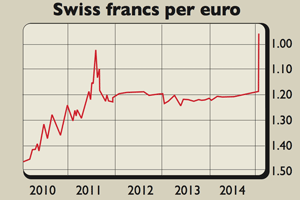
Switzerland has a reputation for being safe and dull. Not now – at least as far as investors go. Last Thursday, the Swiss central bank – the Swiss National Bank (SNB) – caused “a degree of shock and an equal amount of horror”, as one banker puts it in the Financial Times. It ditched its efforts to keep the euro from weakening to below SFr1.20.
The franc jumped by more than 30% against the euro in minutes, a “terrifying swing for an established Western currency”, says Allister Heath in The Daily Telegraph: they rarely move by more than 2%-3% a day.
It ended the day around 14% stronger, trading at near parity (one for one) with the euro, as the below chart shows. Swiss stocks dived 13%, with exporters leading. “Many fortunes were lost.”
From Russian oligarchs financing chalets to “average eastern Europeans, who took out mortgages in Swiss francs”, investors had amassed huge bets on the Swiss exchange rate staying put, says Randall Forsyth in Barron’s.
Some were carry traders, borrowing at rock-bottom interest rates in francs to buy higher-yielding assets elsewhere. Speculators who had borrowed heavily to back their bets lost their shirts. That hit brokers hard, such as Britain’s Alpari.
Why now?
The SNB established the ceiling in 2011, when global investors seeking a safe haven from the eurozone crisis piled into Switzerland. The economy is highly export-dependent; 70% of its GDP stems from foreign sales of goods or services. So a strong currency (which makes a country’s exports more expensive for foreign customers) was depressing the economy and squeezing domestic prices.
Worried that Switzerland could slip into deflation, the SNB said it would print enough money to buy enough euros to ensure the euro didn’t go below SFr1.20.
Why change tack? Politics, partly.
The Swiss, like the Germans, are “viscerally attached to the notion of a ‘healthy’ currency… secure from perceived debasement risks”, says Gavekal Dragonomics. The country recently held a referendum on forcing the central bank to own more gold. It failed, but that it occurred at all is telling.
Moreover, the value of the SNB’s balance sheet has rocketed to 75% of GDP, “a ratio dwarfing that in other economies engaged in unconventional monetary stimulus”, says the FT. SNB fears about European Central Bank (ECB) quantitative easing (QE) forcing more euros into Switzerland must have played a part too.
As the franc shot up, the SNB made losses on its euro holdings, but these might have been even worse later if ECB QE sent the euro plunging. “Already in a hole, the SNB may have decided to stop digging,” said The Economist’s Buttonwood blog.
What next?
Switzerland is still suffering from mild deflation and low growth. Yet the SNB’s other move – cutting its main interest rate by 0.5% to minus 0.75% – to make the franc less appealing, may do little to deter further safe-haven flows. “Haven investors [are] more interested in safety than yield,” says Andrew Bolger in the FT.
Meanwhile, other central banks with exchange-rate targets have been forced to act too. Denmark, another safe haven with a euro peg, trimmed its key lending and bank deposit rates to eurozone levels. It probably won’t stop there. The currency wars have moved to Europe.
The return to gold
The Swiss central bank’s move (see above) boosted demand for gold, which tends to be viewed as a safe haven from financial turmoil. But there are other good reasons behind gold’s rebound to a four-month high of just under $1,300 an ounce.
Mounting expectations of European Central Bank quantitative easing (QE) have made gold “attractive… as a hedge against a debasement of the currency”, says Mitsubishi’s Jonathan Butler – it’s already at a near-two-year high of €1,100 an ounce in euros.
Throw in jittery stockmarkets and gold looks set for further gains. So it’s no wonder that some of the money that rushed out of gold in the past two years is returning. The net amount of money going into the SPDR Gold Trust, the world’s biggest gold-backed exchange-traded fund, is set to turn positive for the first time since July.
But don’t get “carried away”, warns Capital Economics. A return of global risk appetite – aided by QE or a stabilising oil price – would temper safe-haven flows, while US rates are still due to rise. Still, they are unlikely to rise fast and global bond yields should remain low amid growth and deflation fears. Demand from emerging-market central banks and consumers is rising. So there is scope, says Capital, for gold to hit $1,400 by year end.